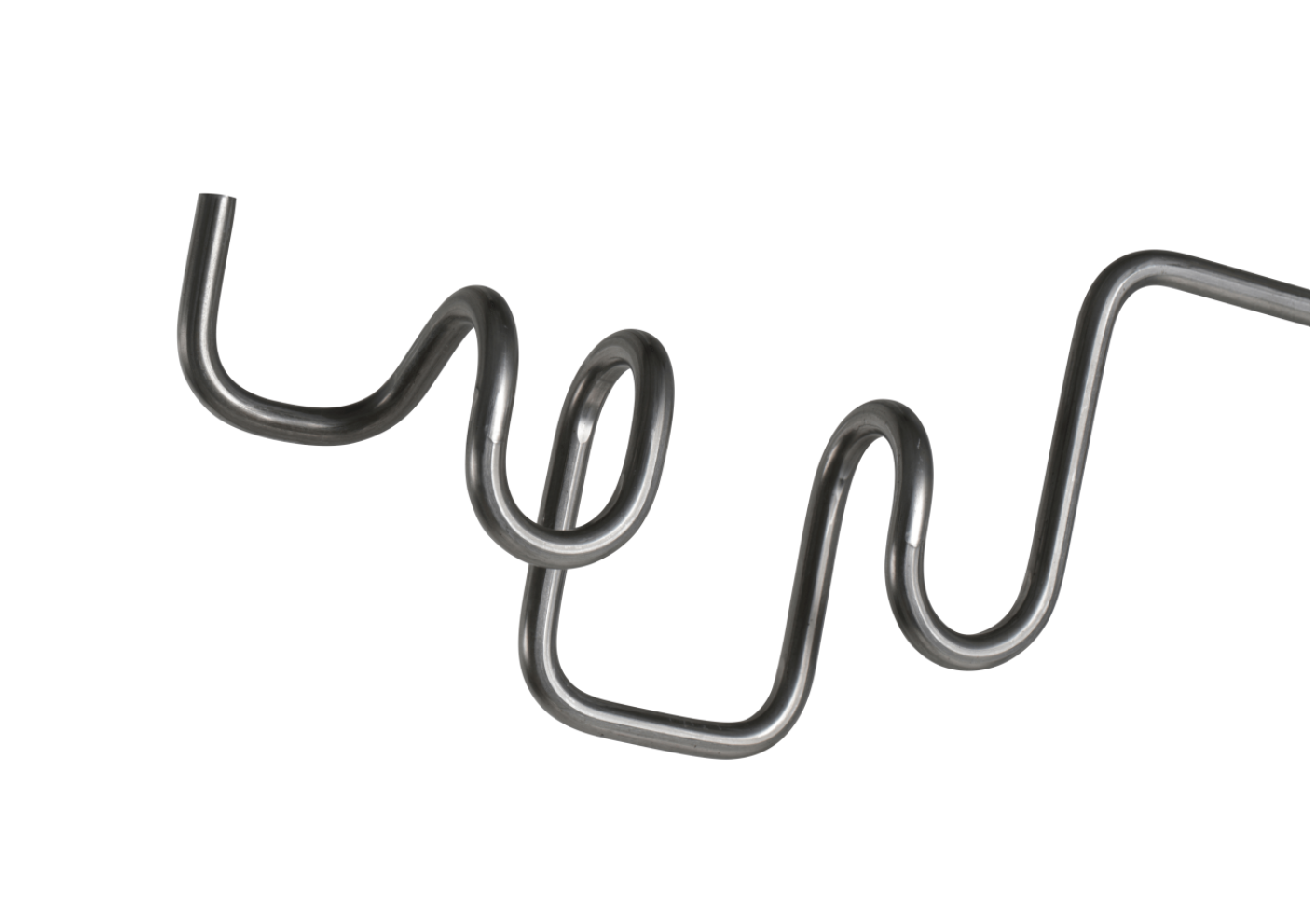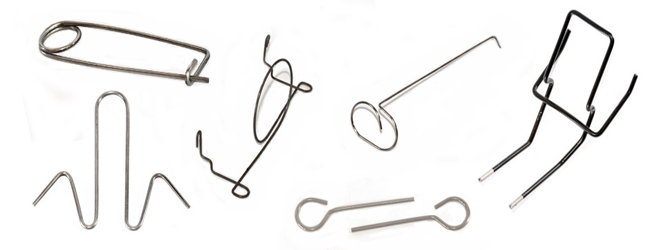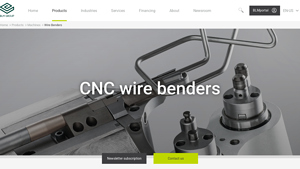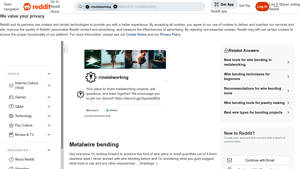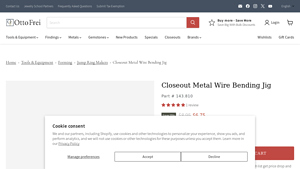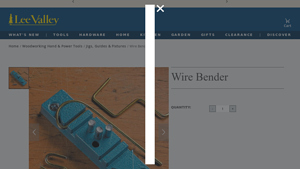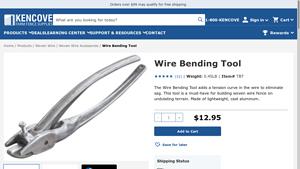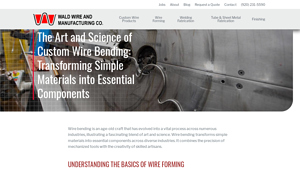Metal Wire Bending Guide: Type, Cost, Top List…
Introduction: Navigating the Global Market for metal wire bending
In an increasingly competitive landscape, sourcing high-quality metal wire bending solutions poses a significant challenge for international B2B buyers. Whether you’re looking to fabricate complex components for the automotive industry or create custom wire shapes for medical applications, understanding the nuances of metal wire bending is crucial. This guide serves as a comprehensive resource, covering various types of wire bending technologies, their applications across different sectors, and essential criteria for vetting suppliers.
By delving into topics such as machine capabilities, cost considerations, and after-sales support, we aim to empower decision-makers from Africa, South America, the Middle East, and Europe—regions that are rapidly expanding their manufacturing capabilities. The insights provided herein will enable businesses to make informed purchasing decisions, ensuring they select the right wire bending solutions tailored to their operational needs.
With the right knowledge at your fingertips, you can navigate the global market confidently, optimizing your supply chain and enhancing productivity. This guide will equip you with the tools to not only evaluate potential suppliers effectively but also to leverage the latest advancements in automated wire bending technology to maximize return on investment.
Understanding metal wire bending Types and Variations
| Type Name | Key Distinguishing Features | Primary B2B Applications | Brief Pros & Cons for Buyers |
|---|---|---|---|
| CNC Wire Bending | Automated, precise control with programmable software | Automotive, aerospace, furniture manufacturing | Pros: High precision, reduced labor costs. Cons: High initial investment. |
| Manual Wire Bending | Hands-on approach, typically lower cost | Craftsmanship, small-scale production | Pros: Low cost, flexibility in design. Cons: Time-consuming, less precision. |
| Robotic Wire Bending | Integration with robotic systems for complex shapes | Industrial automation, custom fabrication | Pros: High speed, flexibility for complex designs. Cons: Requires technical expertise. |
| 2D and 3D Wire Bending | Capability to create flat or three-dimensional shapes | Electronics, medical devices, furniture | Pros: Versatile applications, suitable for prototypes. Cons: May need specialized equipment. |
| Tube Bending | Specifically designed for bending tubes and pipes | Plumbing, automotive exhaust systems | Pros: Ideal for tubular structures, consistent results. Cons: Limited to tube shapes. |
What are the Characteristics of CNC Wire Bending?
CNC wire bending utilizes computer numerical control to automate the bending process, ensuring high precision and repeatability. This method is ideal for large-scale production in industries such as automotive and aerospace, where exact specifications are crucial. B2B buyers should consider the initial investment cost and the potential for increased productivity and reduced labor costs over time. Additionally, CNC machines can be programmed for various wire diameters and shapes, making them highly adaptable to different manufacturing needs.
How Does Manual Wire Bending Compare?
Manual wire bending involves skilled operators using hand tools to shape wire, making it a cost-effective solution for small-scale or custom projects. This method is particularly suitable for artisans and businesses focused on craftsmanship, where intricate designs are required. However, the time-intensive nature of manual bending can lead to inconsistencies and lower productivity compared to automated methods. Buyers should weigh the benefits of lower upfront costs against the potential drawbacks in efficiency and precision.
What are the Advantages of Robotic Wire Bending?
Robotic wire bending integrates advanced robotics to achieve high-speed, complex bending capabilities. This technology is particularly beneficial in industrial automation settings where high-volume production and precision are necessary. Robotic systems can handle intricate designs that may be challenging for traditional methods. However, the complexity of these systems often requires specialized knowledge for setup and operation, which can be a barrier for some businesses.
What Applications Benefit from 2D and 3D Wire Bending?
2D and 3D wire bending techniques allow manufacturers to create both flat and complex three-dimensional shapes. This versatility makes them suitable for a wide range of applications, including electronics, medical devices, and furniture. Businesses looking to prototype or produce custom components will find these bending methods advantageous. However, they may require specialized equipment and software to fully utilize their capabilities, which could involve additional investment.
Why Choose Tube Bending for Specific Needs?
Tube bending is a specialized process aimed at creating precise bends in tubular materials. It is particularly useful in plumbing and automotive applications, where consistent and accurate bends are necessary for functionality. While tube bending excels in producing high-quality tubular structures, it may not be suitable for other types of wire shapes. Buyers should assess their specific needs to determine if tube bending aligns with their production requirements.
Key Industrial Applications of metal wire bending
| Industry/Sector | Specific Application of metal wire bending | Value/Benefit for the Business | Key Sourcing Considerations for this Application |
|---|---|---|---|
| Automotive | Production of custom brackets and supports | Enhanced vehicle performance and reduced weight | Precision specifications, material compatibility |
| Medical Devices | Manufacturing of surgical instruments and implants | Improved patient outcomes and operational efficiency | Regulatory compliance, material biocompatibility |
| Construction | Fabrication of rebar and structural components | Increased structural integrity and cost savings | Material strength, bending accuracy, delivery times |
| Furniture | Creation of custom wire frames and supports | Unique design flexibility and durability | Design specifications, material variety, lead times |
| Electronics | Production of wire harnesses and connectors | Improved assembly efficiency and product reliability | Electrical standards, gauge requirements, sourcing flexibility |
How is Metal Wire Bending Used in the Automotive Industry?
In the automotive sector, metal wire bending is crucial for producing custom brackets and supports that enhance vehicle performance. These components are designed to be lightweight yet robust, contributing to overall vehicle efficiency. International buyers should focus on precision specifications and material compatibility to ensure that the components meet stringent automotive standards. Additionally, sourcing partners with advanced CNC bending technology can significantly reduce lead times, which is essential in a fast-paced industry.
What Role Does Metal Wire Bending Play in Medical Device Manufacturing?
In the medical field, metal wire bending is integral to the production of surgical instruments and implants. The precision and reliability of bent wire components can directly impact patient outcomes and operational efficiency in healthcare settings. Buyers in this sector must prioritize regulatory compliance and material biocompatibility, as these factors are critical in ensuring the safety and effectiveness of medical devices. Collaborating with suppliers who understand the nuances of medical manufacturing can facilitate smoother procurement processes.
How is Metal Wire Bending Applied in Construction?
In construction, metal wire bending is employed for fabricating rebar and other structural components that enhance the integrity of buildings and infrastructure. This application not only supports structural stability but also leads to cost savings through efficient material use. Buyers should consider the strength of the materials and the accuracy of the bending processes when sourcing wire bending services. Timely delivery is also crucial, as construction projects often operate on tight schedules.
What Benefits Does Metal Wire Bending Offer to the Furniture Industry?
The furniture industry leverages metal wire bending for creating custom wire frames and supports that provide unique design flexibility and durability. This capability allows manufacturers to produce innovative designs that stand out in a competitive market. Buyers should ensure that their sourcing partners can accommodate diverse design specifications and provide a variety of materials. Understanding lead times is also important, as it can impact production schedules and market readiness.
How is Metal Wire Bending Utilized in the Electronics Sector?
In electronics, metal wire bending is vital for producing wire harnesses and connectors that enhance assembly efficiency and product reliability. These components must meet specific electrical standards and gauge requirements, making precision in wire bending essential. International buyers should seek suppliers that offer flexibility in sourcing to accommodate varying project sizes and specifications. Ensuring that partners can meet quality standards while also providing timely delivery can significantly impact overall project success.
3 Common User Pain Points for ‘metal wire bending’ & Their Solutions
Scenario 1: Inconsistent Product Quality in Wire Bending
The Problem: A common challenge for B2B buyers in the metal wire bending industry is achieving consistent product quality across different batches. Variations in wire material, bending techniques, and machine calibration can lead to discrepancies in dimensions, strength, and overall finish. This inconsistency not only impacts the end product’s integrity but also leads to increased waste and rework, ultimately affecting profitability and client satisfaction.
The Solution: To overcome this issue, buyers should prioritize investing in advanced CNC wire bending machines that offer precise control over bending parameters. It’s essential to select machines equipped with sophisticated software that allows for real-time monitoring and adjustments. Additionally, establishing a robust quality control process that includes regular calibration of machines and conducting thorough inspections of finished products can significantly enhance consistency. Collaborating with reputable suppliers who provide comprehensive training and support can also ensure that your team is well-equipped to maintain quality standards throughout the production process.
Scenario 2: High Operational Costs Due to Inefficient Processes
The Problem: Many businesses struggle with high operational costs linked to outdated or inefficient wire bending processes. Manual bending techniques and older machines often require extensive labor hours and can lead to increased material waste due to mistakes or inaccuracies. This inefficiency not only affects the bottom line but can also delay project timelines, putting strain on client relationships.
The Solution: Transitioning to automated wire bending systems can dramatically reduce operational costs. By investing in machines that allow for automated setup and rapid changeovers, businesses can significantly decrease production times. It’s crucial to choose machines that can handle a variety of wire types and diameters, ensuring flexibility in production. Additionally, implementing a training program for staff to maximize the use of these machines will lead to improved efficiency and reduced labor costs. Regular maintenance and proactive servicing of equipment will also prevent unexpected downtimes that could disrupt workflow and increase expenses.
Scenario 3: Difficulty in Meeting Customization Requests
The Problem: In today’s competitive market, customers increasingly demand customized solutions, which can be a significant pain point for businesses relying on traditional wire bending methods. Many manufacturers find it challenging to produce complex shapes and designs quickly, leading to missed opportunities and dissatisfied clients. This difficulty can stem from limitations in machine capabilities or a lack of skilled labor familiar with advanced bending techniques.
The Solution: To effectively meet customization demands, businesses should invest in versatile wire bending machines that offer both 2D and 3D bending capabilities. Machines with user-friendly software that accepts G-code can simplify the design process and allow for rapid prototyping. Additionally, forming partnerships with engineering firms can provide access to expertise in design and production, ensuring that even the most complex requests can be fulfilled. Implementing a consultative approach with clients during the design phase can also help clarify their needs and expectations, leading to better alignment and satisfaction with the final product.
Strategic Material Selection Guide for metal wire bending
What Are the Key Properties of Common Materials Used in Metal Wire Bending?
When selecting materials for metal wire bending, understanding the properties and applications of various metals is crucial for optimizing performance and ensuring compatibility with intended uses. Here, we analyze four common materials: stainless steel, aluminum, copper, and carbon steel.
How Does Stainless Steel Perform in Metal Wire Bending Applications?
Stainless steel is renowned for its excellent corrosion resistance and high strength, making it suitable for various applications, including automotive and medical devices. Its temperature rating can withstand high heat, which is essential in environments where thermal stability is a concern.
Pros: Stainless steel offers durability and longevity, making it ideal for products exposed to harsh conditions. It also maintains structural integrity over time, which is critical for safety in applications like construction and transportation.
Cons: The primary drawback is its cost, which is generally higher than other materials. Additionally, the manufacturing complexity can lead to longer lead times and increased production costs, particularly for intricate designs.
Impact on Application: Stainless steel is compatible with a wide range of media, including food and pharmaceuticals, due to its non-reactive nature. This makes it a preferred choice for industries where hygiene is paramount.
Considerations for International Buyers: Buyers from regions like Africa and South America should ensure compliance with international standards such as ASTM A240 or DIN 1.4301 for stainless steel grades. Understanding local availability and import regulations is also vital.
What Advantages Does Aluminum Offer in Wire Bending?
Aluminum is lightweight and has excellent corrosion resistance, making it a popular choice for applications where weight reduction is essential, such as in aerospace and automotive industries. Its thermal and electrical conductivity also makes it suitable for electrical applications.
Pros: The primary advantage of aluminum is its low weight, which can significantly reduce overall product weight. It is also relatively inexpensive compared to stainless steel, making it a cost-effective option for large-scale production.
Cons: Aluminum has lower tensile strength than stainless steel, which may limit its use in high-stress applications. Additionally, it can be more challenging to weld and form, leading to potential manufacturing complexities.
Impact on Application: Aluminum is compatible with various media, but its lower strength limits its use in heavy-duty applications. It’s ideal for lightweight structures but may not be suitable for high-stress environments.
Considerations for International Buyers: Buyers should be aware of the relevant standards, such as ASTM B221 for aluminum alloys, and ensure that suppliers can meet these specifications. Local market preferences may also influence material choice.
How Does Copper Compare in Metal Wire Bending?
Copper is known for its excellent electrical and thermal conductivity, making it the go-to material for electrical wiring and components. Its malleability allows for intricate bending and shaping without cracking.
Pros: The key advantage of copper is its superior conductivity, which is essential for electrical applications. It also has good corrosion resistance, particularly in non-oxidizing environments.
Cons: Copper is more expensive than aluminum and can be less durable in certain applications, particularly those exposed to corrosive environments. It can also tarnish over time, affecting aesthetic appeal.
Impact on Application: Copper is particularly suitable for electrical and electronic applications, where conductivity is paramount. However, it may not be ideal for structural applications due to its lower strength.
Considerations for International Buyers: Compliance with standards such as ASTM B170 for copper and its alloys is crucial. Buyers should also consider the availability of copper in their region, as it may be subject to price fluctuations.
What Role Does Carbon Steel Play in Metal Wire Bending?
Carbon steel is widely used due to its high strength and versatility. It is often employed in applications requiring durability and structural integrity, such as construction and automotive components.
Pros: The primary advantage of carbon steel is its strength and cost-effectiveness, making it suitable for high-stress applications. It can also be easily welded and formed.
Cons: However, carbon steel is prone to rust and corrosion, which may limit its use in outdoor or humid environments unless properly treated. It also has lower corrosion resistance compared to stainless steel.
Impact on Application: Carbon steel is suitable for structural applications but may require protective coatings for longevity in corrosive environments.
Considerations for International Buyers: Buyers should ensure compliance with standards such as ASTM A36 for carbon steel. Understanding local market conditions and treatment options for corrosion resistance is also essential.
Summary Table of Material Selection for Metal Wire Bending
| Material | Typical Use Case for metal wire bending | Key Advantage | Key Disadvantage/Limitation | Relative Cost (Low/Med/High) |
|---|---|---|---|---|
| Stainless Steel | Medical devices, automotive components | Excellent corrosion resistance | Higher cost and manufacturing complexity | High |
| Aluminum | Aerospace, automotive applications | Lightweight and cost-effective | Lower tensile strength | Medium |
| Copper | Electrical wiring, electronic components | Superior electrical conductivity | Higher cost and tarnishing issues | Medium |
| Carbon Steel | Construction, automotive structures | High strength and cost-effective | Prone to rust without treatment | Low |
This strategic material selection guide provides valuable insights for international B2B buyers, enabling informed decisions that align with their operational needs and market conditions.
In-depth Look: Manufacturing Processes and Quality Assurance for metal wire bending
What Are the Key Stages in the Metal Wire Bending Manufacturing Process?
The manufacturing process for metal wire bending consists of several critical stages, each contributing to the overall quality and precision of the final product. Understanding these stages is vital for B2B buyers aiming to source high-quality wire components.
Material Preparation: How Is Wire Prepared for Bending?
The first step in the metal wire bending process involves the careful selection and preparation of raw materials. Wire is typically sourced in coils or straightened lengths, depending on the application. Common materials include stainless steel, copper, and aluminum, each chosen for their specific properties such as tensile strength, corrosion resistance, and flexibility.
Before bending, the wire undergoes inspection to ensure it meets specified diameter and tensile standards. This may involve measuring the wire’s diameter using calipers and testing its tensile strength through standardized methods. Proper preparation is crucial as it affects the performance of the wire during the bending process.
What Techniques Are Used in the Wire Bending Process?
Once the material is prepared, it moves to the forming stage, where various techniques are employed to achieve the desired shapes. Automated CNC wire benders are commonly used, offering high precision and efficiency. These machines can produce both 2D and 3D shapes, accommodating a wide range of wire diameters.
Key bending techniques include:
- Rotational Bending: This method involves rotating the wire around a fixed point to create bends. It’s suitable for simple shapes.
- Interpolated Bending: This technique combines multiple movements of the bending head to create complex geometries. It is particularly useful for producing intricate designs.
- Variable Radius Bending: This allows for bends with varying radii, enhancing design flexibility.
The choice of technique will depend on the specific requirements of the end product, including the complexity of the design and the material properties.
How Is Assembly Conducted in Wire Bending Manufacturing?
In many applications, wire bending is only one part of the overall assembly process. After bending, components may require additional operations such as welding, joining, or fastening to create a complete assembly.
For instance, in the automotive industry, bent wire forms are often integrated with other parts like brackets or clips. The precision of the bending process is crucial here, as any inaccuracies can lead to assembly issues and affect the final product’s performance.
What Quality Assurance Measures Are Important for Wire Bending?
Quality assurance (QA) is integral to the metal wire bending process, ensuring that products meet international standards and customer specifications. B2B buyers must be familiar with the QA protocols adopted by their suppliers.
What International Standards Apply to Metal Wire Bending?
Many manufacturers adhere to international quality management standards, such as ISO 9001, which focuses on maintaining consistent quality in products and services. Additionally, industry-specific certifications like CE marking for products sold in Europe, or API standards for oil and gas applications, are crucial for ensuring compliance with regulatory requirements.
How Are Quality Control Checkpoints Integrated Into the Manufacturing Process?
Quality control (QC) checkpoints are strategically placed throughout the manufacturing process to catch defects early and ensure compliance with quality standards. Common QC checkpoints include:
- Incoming Quality Control (IQC): This involves inspecting raw materials upon receipt to ensure they meet specified standards.
- In-Process Quality Control (IPQC): Throughout the bending and assembly processes, regular inspections are conducted to monitor dimensions and tolerances.
- Final Quality Control (FQC): Before products are shipped, a final inspection ensures that all specifications are met and that the product is free from defects.
Testing methods often include dimensional checks, tensile tests, and visual inspections to verify the integrity of the bent wire components.
How Can B2B Buyers Verify Supplier Quality Control Practices?
For international B2B buyers, especially those from regions like Africa, South America, the Middle East, and Europe, verifying supplier QC practices is paramount to ensure product reliability.
What Steps Can Be Taken to Conduct Supplier Audits?
Conducting supplier audits is an effective way to assess a manufacturer’s quality control practices. Buyers can request audits to evaluate:
- Compliance with international quality standards.
- The effectiveness of their QC processes.
- Traceability of materials and processes.
Buyers may also consider third-party inspections as a means to verify quality. Engaging an independent inspection agency can provide an unbiased assessment of the supplier’s capabilities and adherence to quality standards.
What Documentation Should B2B Buyers Request from Suppliers?
Documentation is a key component of verifying quality assurance practices. B2B buyers should request:
- Certificates of Compliance: Proof that products meet relevant industry standards.
- Quality Control Reports: Detailed records of inspections and tests conducted throughout the manufacturing process.
- Traceability Records: Documentation that tracks the source of materials and their journey through the production process.
Having access to this information not only assures the buyer of the product quality but also supports compliance with import regulations in their respective regions.
What Are the Nuances of Quality Certification for International Buyers?
International buyers must navigate different quality certification requirements based on their regions. For instance, products exported to Europe must comply with CE standards, while those intended for markets in the Middle East may require local certifications. Understanding these nuances is crucial for seamless trade and compliance.
By being informed about the manufacturing processes and quality assurance measures in metal wire bending, B2B buyers can make more informed decisions, ensuring they procure high-quality components tailored to their specific needs.
Practical Sourcing Guide: A Step-by-Step Checklist for ‘metal wire bending’
Introduction
This practical sourcing guide is designed to assist B2B buyers in the metal wire bending sector. By following this step-by-step checklist, you will be equipped to make informed decisions when selecting equipment or suppliers, ensuring that you acquire the best solutions tailored to your business needs.
Step 1: Define Your Technical Specifications
Before initiating the procurement process, clearly outline your technical requirements. This includes the type of wire materials you intend to use, the diameters needed, and the complexity of shapes you want to achieve.
– Consider: Will you require 2D or 3D bending capabilities?
– Assess: The production volume and frequency can influence the machine size and specifications.
Step 2: Research Market Trends and Innovations
Stay updated on the latest advancements in wire bending technology. Understanding current market trends will help you identify innovative solutions that can enhance your production capabilities.
– Explore: Automated systems that increase efficiency and precision.
– Investigate: Emerging technologies like CNC wire benders that offer greater versatility and programmability.
Step 3: Evaluate Potential Suppliers
Thoroughly vet potential suppliers to ensure they meet your specific requirements. Request company profiles, case studies, and references from clients in similar industries or regions.
– Look for: Suppliers with a proven track record of reliability and innovation.
– Ask for: Demonstrations of their machines and any customization options available.
Step 4: Verify Certifications and Compliance
Ensure that the suppliers you are considering adhere to international standards and certifications. This is crucial for maintaining product quality and safety.
– Check: ISO certifications or other relevant industry standards.
– Confirm: Compliance with local regulations in your target market, especially if importing machinery.
Step 5: Request Quotes and Compare Costs
Gather detailed quotations from multiple suppliers to compare pricing structures. Be sure to understand what each quote includes, such as installation, training, and after-sales support.
– Analyze: The total cost of ownership, which includes not only the purchase price but also maintenance and operational costs.
– Negotiate: Leverage your research to negotiate better terms or discounts.
Step 6: Assess After-Sales Support and Training
Evaluate the level of after-sales support provided by the supplier. This includes installation, training, and ongoing maintenance services.
– Inquire: About the availability of technical support and response times for troubleshooting.
– Consider: The quality of training programs, as proper training can significantly impact your operational efficiency.
Step 7: Make a Decision Based on Comprehensive Evaluation
After completing the previous steps, compile all gathered information and assess each supplier against your defined criteria. Make a decision that aligns with your operational goals and budget.
– Reflect: On the long-term partnership potential with the supplier.
– Trust your instincts: Choose a supplier that demonstrates a clear understanding of your needs and provides a compelling value proposition.
By following this checklist, you will be well-prepared to source metal wire bending solutions that meet your business requirements effectively.
Comprehensive Cost and Pricing Analysis for metal wire bending Sourcing
What Are the Key Cost Components for Metal Wire Bending?
When sourcing metal wire bending services, understanding the cost structure is crucial for international B2B buyers. The primary cost components include:
-
Materials: The type of wire used significantly impacts the cost. Common materials like stainless steel or aluminum vary in price based on market conditions. Specialty wires, such as those used in medical applications, can be more expensive due to their specific properties and certifications.
-
Labor: Skilled labor is required for both manual bending and operating automated machines. Labor costs can vary widely based on the country of operation, with regions like Europe typically experiencing higher labor costs compared to some South American or African countries.
-
Manufacturing Overhead: This includes costs associated with facility maintenance, utilities, and equipment depreciation. Automated machines, while initially costly, can reduce labor costs and increase efficiency, thus lowering overall manufacturing overhead in the long run.
-
Tooling: Custom tooling is often necessary for unique bending requirements. The cost of tooling can be significant, especially for low-volume orders, but is usually amortized over larger production runs.
-
Quality Control (QC): Ensuring that products meet specific standards involves additional costs. Investment in QC processes can prevent costly reworks or returns, making it a vital aspect of the cost structure.
-
Logistics: Shipping costs can vary based on the distance and the logistics provider. For international buyers, understanding Incoterms is essential, as they dictate who bears the shipping costs and risks.
-
Margin: Suppliers typically apply a markup to cover their costs and generate profit. This margin can fluctuate based on competition, demand, and the specific needs of the buyer.
How Do Price Influencers Affect Metal Wire Bending Costs?
Several factors influence pricing in metal wire bending, particularly for international buyers:
-
Volume/MOQ: Higher order volumes often lead to reduced per-unit costs due to economies of scale. Suppliers may offer better pricing for larger orders, making it beneficial for buyers to consolidate their needs.
-
Specifications and Customization: Custom designs or specific tolerances can increase costs. Buyers should be clear about their requirements to avoid unexpected expenses.
-
Material Choice: The choice of material not only affects the base cost but also influences processing time and machine wear, which can further impact pricing.
-
Quality and Certifications: Products that require specific certifications (e.g., ISO, ASTM) may incur additional costs. Buyers should consider the importance of these certifications relative to their end-use applications.
-
Supplier Factors: The supplier’s reputation, production capacity, and location can all influence pricing. Suppliers with advanced technology or unique capabilities may command higher prices.
-
Incoterms: Understanding the implications of various Incoterms (e.g., FOB, CIF) can help buyers manage their overall costs effectively, as these terms dictate who is responsible for shipping, insurance, and customs duties.
What Are Effective Buyer Tips for Cost-Efficient Metal Wire Bending Sourcing?
For B2B buyers, particularly those operating in regions such as Africa, South America, the Middle East, and Europe, here are some strategic tips:
-
Negotiate Pricing: Don’t hesitate to negotiate with suppliers. Presenting your needs clearly can lead to better terms, especially if you can commit to larger volumes or longer contracts.
-
Consider Total Cost of Ownership: Evaluate not just the purchase price but also the long-term costs associated with maintenance, quality issues, and logistics. A slightly higher upfront cost might lead to significant savings over time if it results in fewer defects or lower shipping costs.
-
Understand Pricing Nuances: Be aware that international transactions may involve additional fees such as tariffs or import duties. Factor these into your overall budget to avoid surprises.
-
Evaluate Local Suppliers: Depending on your location, sourcing from local suppliers can significantly reduce shipping costs and lead times, ultimately enhancing your supply chain efficiency.
-
Request Samples: Before committing to large orders, request samples to assess quality. This step can help ensure that the supplier meets your specifications and reduces the risk of costly returns.
Disclaimer on Indicative Prices
Prices for metal wire bending services can vary significantly based on the aforementioned factors, as well as market conditions. It is essential to conduct thorough research and obtain multiple quotes to ensure competitive pricing for your specific needs.
Alternatives Analysis: Comparing metal wire bending With Other Solutions
The landscape of wire forming and fabrication offers several solutions to meet diverse business needs. While metal wire bending is a popular choice, understanding its alternatives can help B2B buyers make informed decisions that align with their specific requirements.
| Comparison Aspect | Metal Wire Bending | Automated CNC Wire Forming | Manual Wire Forming |
|---|---|---|---|
| Performance | High precision for complex shapes | Exceptional precision and speed for large volumes | Variable precision, labor-dependent |
| Cost | Moderate initial investment; lower operational costs | Higher upfront costs; potential for long-term savings | Low initial cost; higher labor costs over time |
| Ease of Implementation | Requires training for optimal use | Steeper learning curve; requires skilled operators | Simple to start; no specialized training needed |
| Maintenance | Regular maintenance needed | Minimal with advanced systems | High maintenance due to wear and tear |
| Best Use Case | Custom parts, prototypes, small batches | Mass production, complex designs | Low-volume, simple shapes |
What Are the Advantages and Disadvantages of Automated CNC Wire Forming?
Automated CNC wire forming machines offer a high level of precision and efficiency, making them ideal for mass production. These machines can handle complex designs quickly and consistently, which is crucial for industries requiring high-volume outputs, such as automotive and aerospace. However, the initial investment can be substantial, and the machines require skilled operators and regular software updates to function optimally. For businesses focused on long-term efficiency and output, CNC machines represent a significant advantage despite their higher costs.
How Does Manual Wire Forming Compare to Metal Wire Bending?
Manual wire forming is the most straightforward approach, requiring minimal investment and no specialized machinery. It allows for flexibility and immediate adjustments during the bending process, making it suitable for artisans and small businesses producing low volumes or custom pieces. However, this method heavily relies on the skill of the operator, which can lead to inconsistencies in quality. As production scales, the costs associated with labor and potential errors can escalate, making manual methods less viable for larger operations.
Conclusion: How to Choose the Right Wire Forming Solution for Your Business?
When selecting the right wire forming solution, consider your production volume, the complexity of the designs, and your budget. Automated CNC wire forming is best for high-volume production where precision is paramount, while metal wire bending serves well for custom or small-batch needs. Manual wire forming may be suitable for startups or artisans focusing on unique, low-volume projects. Each method presents its own advantages and challenges; therefore, aligning the choice with your operational requirements will ensure optimal efficiency and cost-effectiveness.
Essential Technical Properties and Trade Terminology for metal wire bending
What Are the Key Technical Properties in Metal Wire Bending?
Understanding the essential technical properties of metal wire bending is crucial for B2B buyers, especially those involved in manufacturing and production. Here are some critical specifications to consider:
-
Material Grade
– The material grade refers to the type of wire used in the bending process, such as stainless steel, copper, or aluminum. Different grades offer varying levels of strength, flexibility, and corrosion resistance. Choosing the right material is vital for ensuring the durability and performance of the final product, impacting both cost and quality. -
Wire Diameter
– This specification indicates the thickness of the wire, typically measured in millimeters or inches. Common diameters range from 0.4 mm to 12 mm, depending on the application. Wire diameter affects the bending capacity and the complexity of shapes that can be achieved. A precise understanding of diameter requirements can help in selecting the appropriate bending machine. -
Bending Tolerance
– Bending tolerance is the allowable deviation from the specified angle or shape during the wire bending process. It is critical for ensuring that components fit together correctly in final assemblies. Tighter tolerances can lead to higher production costs but are necessary for high-precision applications, such as in the aerospace or automotive industries. -
Bend Radius
– The bend radius is the minimum radius that can be achieved when bending the wire. A smaller bend radius can create tighter curves, which may be essential for specific designs. Understanding the limitations of bend radius is crucial for optimizing designs and ensuring that the wire does not suffer from stress fractures during the bending process. -
Production Speed
– This refers to the rate at which a wire bending machine can produce finished parts. Higher production speeds can significantly impact overall efficiency and cost-effectiveness, making it an essential factor for businesses looking to scale operations. Automated machines often provide faster production times, which is a significant consideration for B2B buyers. -
Surface Finish
– The surface finish of bent wire can affect aesthetics, corrosion resistance, and functionality. Different finishes may require additional processes, impacting lead times and costs. Buyers should specify surface finish requirements to ensure compatibility with their products’ end-use.
What Are Common Trade Terms in Metal Wire Bending?
Navigating the metal wire bending industry also requires familiarity with specific trade terminology. Here are some commonly used terms that can aid in effective communication and decision-making:
-
OEM (Original Equipment Manufacturer)
– OEM refers to companies that produce parts and equipment that may be marketed by another manufacturer. Understanding OEM relationships is crucial for B2B buyers as it impacts sourcing, branding, and product quality. -
MOQ (Minimum Order Quantity)
– MOQ indicates the smallest quantity of a product that a supplier is willing to sell. This term is essential for budget-conscious buyers who need to manage inventory while ensuring they meet production demands. -
RFQ (Request for Quotation)
– An RFQ is a document that buyers send to suppliers to request pricing and terms for specific products or services. This is a critical step in the procurement process, allowing buyers to compare offers and negotiate terms effectively. -
Incoterms (International Commercial Terms)
– Incoterms are a series of predefined commercial terms published by the International Chamber of Commerce (ICC) that outline the responsibilities of buyers and sellers in international transactions. Familiarity with these terms helps businesses understand shipping responsibilities, risk, and cost allocation. -
Lead Time
– Lead time refers to the amount of time it takes from placing an order until the product is delivered. In the metal wire bending industry, understanding lead times is crucial for production planning and meeting delivery commitments. -
Custom Fabrication
– This term refers to the process of creating custom parts and components tailored to specific requirements. Custom fabrication is often a necessity in wire bending to meet unique design specifications, emphasizing the importance of supplier capabilities in this area.
By grasping these technical properties and trade terms, B2B buyers can make informed decisions that enhance their production efficiency and product quality in metal wire bending applications.
Navigating Market Dynamics and Sourcing Trends in the metal wire bending Sector
What Are the Key Market Dynamics in the Metal Wire Bending Sector?
The global metal wire bending market is experiencing significant growth driven by increasing demand across various industries, such as automotive, furniture, and industrial applications. Key trends include the rise of automated wire bending technologies, which enhance productivity and precision while reducing labor costs. Automated CNC wire formers are becoming particularly popular among manufacturers looking to optimize their operations. Additionally, the integration of advanced software solutions, such as user-friendly interfaces and G-code compatibility, is enabling businesses to customize their production processes effectively.
International B2B buyers, particularly from regions like Africa, South America, the Middle East, and Europe, must navigate a complex landscape influenced by regional economic conditions, trade policies, and technological advancements. For instance, buyers in Africa and South America are increasingly focusing on sourcing from local suppliers to mitigate risks associated with long supply chains and fluctuating transportation costs. Conversely, European buyers may prioritize suppliers with advanced manufacturing capabilities that can meet stringent quality standards and offer quick turnaround times.
Another emerging trend is the growing importance of data analytics in production processes. Manufacturers are utilizing data-driven insights to streamline operations, predict maintenance needs, and enhance product quality. As international buyers seek to partner with suppliers who embrace these technologies, the ability to showcase technological capabilities and operational efficiencies will become a critical differentiator in the marketplace.
How Is Sustainability Influencing Sourcing Decisions in Metal Wire Bending?
Sustainability is increasingly becoming a key consideration for B2B buyers in the metal wire bending sector. Companies are under pressure to minimize their environmental impact and ensure ethical sourcing practices throughout their supply chains. This shift is driven by both regulatory requirements and consumer demand for more sustainable products. As a result, buyers are looking for suppliers that can provide “green” certifications and utilize eco-friendly materials in their manufacturing processes.
The environmental impact of metal wire bending is significant, particularly in terms of energy consumption and waste generation. Suppliers that implement energy-efficient technologies, such as all-electric wire bending machines, can significantly reduce their carbon footprint. Additionally, the use of recycled materials in wire production not only conserves resources but also appeals to environmentally conscious buyers.
Ethical sourcing is also paramount, as companies strive to ensure that their suppliers adhere to fair labor practices and sustainable production methods. By partnering with suppliers committed to ethical standards, B2B buyers can enhance their corporate social responsibility profiles and meet the expectations of their stakeholders. This trend towards sustainability and ethical sourcing is likely to shape future procurement strategies within the metal wire bending industry.
What Is the Historical Context of Metal Wire Bending Technology?
The evolution of metal wire bending technology has been marked by significant advancements that have transformed manufacturing processes. Historically, wire bending was a labor-intensive manual process, which limited the complexity and precision of the shapes that could be produced. The introduction of mechanical bending machines in the mid-20th century began to automate these processes, increasing efficiency and consistency.
With the advent of computer numerical control (CNC) technology in the late 20th century, manufacturers gained the ability to produce intricate designs with remarkable accuracy. This shift not only improved production speeds but also allowed for greater customization in wire bending applications. Today, the integration of sophisticated software and automation technologies continues to drive innovation, enabling manufacturers to meet the evolving demands of various industries while enhancing their operational capabilities. As the market moves forward, the historical context of these developments will serve as a foundation for future advancements in the metal wire bending sector.
Frequently Asked Questions (FAQs) for B2B Buyers of metal wire bending
-
How do I solve issues with wire bending precision?
To enhance precision in wire bending, consider investing in automated CNC wire bending machines that offer advanced programming and control capabilities. These machines utilize sophisticated software to execute complex bends with high accuracy, reducing human error. Regular maintenance and calibration of your equipment are essential to ensure consistent performance. Additionally, using quality materials that are suited for your specific bending requirements can significantly improve precision. -
What is the best wire bending machine for small batch production?
For small batch production, the D.I.Wire Pro is an excellent choice due to its user-friendly interface and capability to handle various wire diameters. It allows for quick adjustments and setup changes, making it ideal for producing custom shapes efficiently. Its compact size and versatility also make it suitable for limited workspace environments. Ensure the machine you choose can accommodate the specific materials and shapes you intend to produce. -
How do I vet suppliers for metal wire bending services?
When vetting suppliers, prioritize those with a proven track record in the metal wire bending industry. Request case studies or references from previous clients to assess their capabilities. Evaluate their certifications and adherence to quality standards, such as ISO 9001. Additionally, consider their ability to provide customized solutions and their experience with international shipping and logistics, especially for your region. -
What is the typical minimum order quantity (MOQ) for wire bending products?
Minimum order quantities can vary significantly depending on the supplier and the complexity of the wire bending project. For standard products, MOQs may start from as low as 100 units, while custom designs might require higher quantities to justify production costs. It’s advisable to discuss your specific needs with potential suppliers to negotiate favorable terms that align with your business volume. -
What payment terms should I expect when sourcing wire bending services internationally?
Payment terms can vary by supplier, but common practices include upfront deposits (typically 30% to 50%) followed by balance payments upon completion or before shipment. Letters of credit are also frequently used for international transactions to mitigate risk. Ensure to clarify terms related to payment methods, currency, and any additional fees associated with international transactions before finalizing agreements. -
How can I ensure quality assurance in wire bending products?
To ensure quality assurance, request detailed specifications and tolerances from suppliers before production. Implement a quality control process that includes inspections at various stages of the production cycle. Many reputable suppliers provide documentation, such as inspection reports and certifications, to verify compliance with industry standards. Consider establishing a clear return policy to address any defects or discrepancies promptly. -
What logistics considerations should I keep in mind when importing wire bending machinery?
When importing wire bending machinery, consider shipping costs, delivery timelines, and customs regulations for your region. Research the best shipping methods for heavy machinery, such as freight shipping, and factor in any additional costs like insurance and handling. Ensure that the supplier provides the necessary documentation for customs clearance to avoid delays. Working with a logistics partner experienced in international shipping can streamline this process. -
How do I customize wire bending solutions to fit my production needs?
Customizing wire bending solutions starts with a comprehensive assessment of your specific requirements, including wire type, diameter, and desired shapes. Engage with suppliers who offer consultative sales approaches to understand your workflow and operational needs. Many advanced machines can be configured with different tooling and software options to accommodate unique applications. Discuss your project goals and constraints upfront to ensure the final solution aligns perfectly with your production processes.
Important Disclaimer & Terms of Use
⚠️ Important Disclaimer
The information provided in this guide, including content regarding manufacturers, technical specifications, and market analysis, is for informational and educational purposes only. It does not constitute professional procurement advice, financial advice, or legal advice.
While we have made every effort to ensure the accuracy and timeliness of the information, we are not responsible for any errors, omissions, or outdated information. Market conditions, company details, and technical standards are subject to change.
B2B buyers must conduct their own independent and thorough due diligence before making any purchasing decisions. This includes contacting suppliers directly, verifying certifications, requesting samples, and seeking professional consultation. The risk of relying on any information in this guide is borne solely by the reader.
Top 7 Metal Wire Bending Manufacturers & Suppliers List
1. BLM GROUP – CNC Wire Benders
Domain: blmgroup.com
Registered: 2000 (25 years)
Introduction: CNC wire benders from BLM GROUP include:
1. E-FLEX:
– Type: Single-headed wire bender
– Ideal for: Making complex 3D shapes
– Capacity: Up to Ø .39″ (10 mm)
– Material: Processes wire from coil
2. DH40:
– Type: Double-headed wire bending machine
– Ideal for: Medium-long, symmetrical parts, bars, and armored resistors
– Capacity: Up to Ø .47″ (12 mm)
– Material: P…
2. Reddit – Wire Bending Tools for Stainless Steel
Domain: reddit.com
Registered: 2005 (20 years)
Introduction: The user is looking to produce wire pieces in small quantities from 4-6mm stainless steel. They are seeking suggestions for tools to use for wire bending, as they have no prior experience in this area.
3. Otto Frei – Metal Wire Bending Jig
Domain: ottofrei.com
Registered: 2000 (25 years)
Introduction: This company, Otto Frei – Metal Wire Bending Jig, is a notable entity in the market. For specific product details, it is recommended to visit their website directly.
4. Lee Valley – Wire Bender
Domain: leevalley.com
Registered: 1996 (29 years)
Introduction: {“name”: “Wire Bender”, “description”: “A jig for bending mild steel wire up to 3/16″ or 5mm diameter into any shape, ideal for creating custom tool holders or pegboard hooks from coat-hanger wire.”, “material”: “Mild steel”, “dimensions”: “Up to 3/16″ or 5mm diameter”, “origin”: “Made in Japan”, “price”: “$12.50”, “model_number”: “92W6701”}
5. Kencove – Wire Bending Tool
Domain: kencove.com
Registered: 1996 (29 years)
Introduction: This company, Kencove – Wire Bending Tool, is a notable entity in the market. For specific product details, it is recommended to visit their website directly.
6. Wire Forms – CNC Wire Bending Solutions
Domain: wire-forms.net
Registered: 2001 (24 years)
Introduction: CNC Wire Bending is a process that utilizes Computer Numerical Control (CNC) machines to bend wire with precision. These machines can handle wire diameters from .050 to .500 inches and are capable of producing custom bends at specific angles. They can be single or double-headed, fully electric, and equipped with integrated load and unload capabilities. The machines accept various wire types, inclu…
7. Wald Wire – Custom Wire Bending Solutions
Domain: waldwire.com
Registered: 2000 (25 years)
Introduction: Custom wire bending involves shaping wire into desired forms using various techniques and tools, based on principles of physics. Common materials used include stainless steel and mild steel, known for their strength, flexibility, conductivity, and corrosion resistance. Tools and machinery include manual benders for simple tasks and CNC machines for intricate designs. Applications span multiple ind…
Strategic Sourcing Conclusion and Outlook for metal wire bending
In the competitive landscape of metal wire bending, strategic sourcing emerges as a pivotal factor for success. By aligning with advanced technology providers, businesses can enhance productivity, reduce operational costs, and improve product quality. The integration of automated wire bending machines not only streamlines production processes but also offers customization options that cater to diverse industry needs, from automotive to furniture manufacturing.
International B2B buyers from regions such as Africa, South America, the Middle East, and Europe stand to gain significantly by adopting these innovations. The ability to source machines that are not only efficient but also tailored to specific requirements can lead to a remarkable increase in return on investment (ROI). Additionally, the consultative approach taken by leading manufacturers ensures that businesses receive ongoing support, facilitating a smooth transition to automated solutions.
As you consider your sourcing strategies, prioritize partnerships with suppliers who demonstrate a commitment to innovation and customer satisfaction. The future of metal wire bending is bright, with technological advancements paving the way for unprecedented opportunities. Seize the moment—invest in the right solutions today to secure your competitive edge tomorrow.
